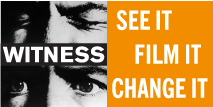Published November, 2014 by Kelly Matheson in Law, Resources
Video as Evidence: Adding Detailed Information to Your Video
This is the third post in our Video as Evidence Field Guide series. Read more about the Field Guide here or below.
In this post, we discuss how adding detailed information to your footage or video of a human rights incident helps to verify its content and improve the chances that it will be considered evidence. For video to be evidence, investigators, analysts and lawyers must be able to prove:
- When: The date and time of the filming
- Where: The location
- What: That the content in the video is, in fact, what it says it is and if safe,
- Who: The person that captured the footage on camera
Easier verification means there is a better chance that the video will be useful to secure justice. By adapting the steps below and the script included in this document to fit your situation and security limitations, you can enhance the evidentiary value of video you take the time and risk to collect.
Before Proceeding, Carefully Consider If It Is Safe To Do So
Filming for human rights can be dangerous. Your safety, and the safety of the individuals and communities you are working to protect, is always more important than capturing footage. Before you film, be sure to consider:
- Whether filming is an appropriate documentation tool or not?
- If so, ask yourself whether it’s safe to disclose your identify and the identity of others on scene or whether you should film anonymously and hide the identities on those you film. If you decide it’s safe to film, disclose your identity and the identities of other individuals on scene, then here are some ideas on how you can add essential information to your video using narration or a written camera slate.
Four Steps to Adding Essential Information to Your Evidentiary Video
If you have determined it is safe to include essential information then, use the camera microphone or a piece of paper to add the following information:

STEP 1- WHO, WHEN & WHERE: Introductory Information
Begin by recording your name, contact information, date, time, location and the names and contact information of other individuals that may have information about the incident.
STEP 2 – HOW: Orient Your Viewers by Describing How You Will Film
While filming, clearly state how you are filming the scene – from north to south, from above the scene, etc.
STEP 3 [OPTIONAL] WHAT: Factually Describe What the Video Documents
If appropriate for your situation, add a concise and factual description of the human rights content the viewer sees to the recording. To help you determine whether you should include a description of the footage, download more information here. In short, if you provide descriptions, include only facts and leave out unsupported opinions.
STEP 4 Wrap Up Filming
End by stating the time you completed filming.
REMEMBER:
– Adapt the above as necessary to fit your situation.
– Provide only factual information.
– Leave out unsupported opinions.
– If you need to film anonymously, see Techniques for Filming Anonymously.
Here’s An Example of the Four Steps
My name is Morgan Wells. I work for the organization EVIDENCE and can be contacted at morgan@xxxxx.com or +1 111.222.3333. This video footage was captured on January 25, 2015 beginning at 11:13 am at 800 Wall St., New York, NY, USA.
Other people who are here on scene with me and who may have relevant information about the likely arrest at the corner of Wall Street and Pearl Street in New York are:
- John Smith, 800 Wall Street, 5th Floor, New York, NY, USA, john@xxxxx.com, +1 111.222.3333; and
- Jane Williams, 800 Wall Street, 5th Floor, New York, NY, USA, jane@xxxxx.com, +1 111.222.3333
The footage is captured from a 5th floor window located on the southeast corner of the building. I am filming from the window looking down onto the scene on the street at the corner of Wall St. and Pearl St. This was the only vantage point from which I was able to film.
OPTIONAL: The video captured here documents an alleged use of excessive force by the New York Police Department against an African American man who appears to be in his early 20s. No protests were taking place at the time and I do not know what sparked the incident.
I completed filming this incident at 10:30 am.
More on Adding Essential Information To a Video For Evidence
To learn more about Adding Essential Information to a video for evidence, especially to learn about why Step 3 is optional and how to implement this step, view and download this section from the forthcoming Video as Evidence Field Guide. Also available is a mini guide which can be a useful overview and recap of the steps. The section from the Guide provides step-by-step directions on how to do so that you can tailor to your own situation on-the-ground as well as a script that you can modify.
***
Additional information on the Video as Evidence Field Guide:
Content in the Video as Evidence Field Guide Series is drawn from our work with input from attorneys, investigators, analysts, legal scholars, funders and our peers documenting violations on-the-ground. The Field Guide aims to improve the reliability and effectiveness of video shot for human rights documentation and for use as evidence in criminal and civil justice processes. Click here to read all posts in the series.
The post Video as Evidence: Adding Detailed Information to Your Video appeared first on WITNESS Blog.

